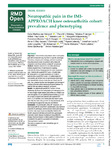Mostrar o rexistro simple do ítem
Neuropathic pain in the IMI-APPROACH knee osteoarthritis cohort: prevalence and phenotyping
| dc.contributor.author | van Helvoort, Eefje M. | |
| dc.contributor.author | Welsing, Paco M.J. | |
| dc.contributor.author | Jansen, Mylène P. | |
| dc.contributor.author | Gielis, Willem Paul | |
| dc.contributor.author | Loef, Marieke | |
| dc.contributor.author | Kloppenburg, Margreet | |
| dc.contributor.author | Blanco García, Francisco J | |
| dc.contributor.author | Haugen, Ida K. | |
| dc.contributor.author | Berenbaum, Francis | |
| dc.contributor.author | Bay-Jensen, Anne-C | |
| dc.contributor.author | Ladel, Christoph H. | |
| dc.contributor.author | Lalande, Agnes | |
| dc.contributor.author | Larkin, Jonathan | |
| dc.contributor.author | Loughlin, John | |
| dc.contributor.author | Mobasheri, Ali | |
| dc.contributor.author | Weinans, Harrie | |
| dc.contributor.author | Lafeber, Floris | |
| dc.contributor.author | Eijkelkamp, Niels | |
| dc.contributor.author | Mastbergen, Simon | |
| dc.date.accessioned | 2022-01-13T07:51:48Z | |
| dc.date.available | 2022-01-13T07:51:48Z | |
| dc.date.issued | 2021-12-15 | |
| dc.identifier.citation | van Helvoort EM, Welsing PMJ, Jansen MP, Gielis WP, Loef M, Kloppenburg M, Blanco F, Haugen IK, Berenbaum F, Bay-Jensen AC, Ladel C, Lalande A, Larkin J, Loughlin J, Mobasheri A, Weinans H, Lafeber F, Eijkelkamp N, Mastbergen S. Neuropathic pain in the IMI-APPROACH knee osteoarthritis cohort: prevalence and phenotyping. RMD Open. 2021 Dec;7(3):e002025. | es_ES |
| dc.identifier.issn | 2056-5933 | |
| dc.identifier.uri | http://hdl.handle.net/2183/29374 | |
| dc.description | The study is registered under clinicaltrials.gov nr: NCT03883568. | es_ES |
| dc.description.abstract | [Abstract] Objectives: Osteoarthritis (OA) patients with a neuropathic pain (NP) component may represent a specific phenotype. This study compares joint damage, pain and functional disability between knee OA patients with a likely NP component, and those without a likely NP component. Methods: Baseline data from the Innovative Medicines Initiative Applied Public-Private Research enabling OsteoArthritis Clinical Headway knee OA cohort study were used. Patients with a painDETECT score ≥19 (with likely NP component, n=24) were matched on a 1:2 ratio to patients with a painDETECT score ≤12 (without likely NP component), and similar knee and general pain (Knee Injury and Osteoarthritis Outcome Score pain and Short Form 36 pain). Pain, physical function and radiographic joint damage of multiple joints were determined and compared between OA patients with and without a likely NP component. Results: OA patients with painDETECT scores ≥19 had statistically significant less radiographic joint damage (p≤0.04 for Knee Images Digital Analysis parameters and Kellgren and Lawrence grade), but an impaired physical function (p<0.003 for all tests) compared with patients with a painDETECT score ≤12. In addition, more severe pain was found in joints other than the index knee (p≤0.001 for hips and hands), while joint damage throughout the body was not different. Conclusions: OA patients with a likely NP component, as determined with the painDETECT questionnaire, may represent a specific OA phenotype, where local and overall joint damage is not the main cause of pain and disability. Patients with this NP component will likely not benefit from general pain medication and/or disease-modifying OA drug (DMOAD) therapy. Reserved inclusion of these patients in DMOAD trials is advised in the quest for successful OA treatments. | es_ES |
| dc.language.iso | eng | es_ES |
| dc.publisher | BMJ | es_ES |
| dc.relation.uri | http://dx.doi.org/10.1136/rmdopen-2021-002025 | es_ES |
| dc.rights | Creative Commons Attribution-NonCommercial 4.0 International License (CC-BY-NC 4.0) | es_ES |
| dc.rights.uri | http://creativecommons.org/licenses/by-nc/4.0/ | * |
| dc.subject | Knee osteoarthritis | es_ES |
| dc.subject | Patient reported outcome measures | es_ES |
| dc.subject | Therapeutics | es_ES |
| dc.title | Neuropathic pain in the IMI-APPROACH knee osteoarthritis cohort: prevalence and phenotyping | es_ES |
| dc.type | info:eu-repo/semantics/article | es_ES |
| dc.rights.access | info:eu-repo/semantics/openAccess | es_ES |
| UDC.journalTitle | RMD Open | es_ES |
| UDC.volume | 7 | es_ES |
| UDC.issue | 3 | es_ES |
| UDC.startPage | e002025 | es_ES |
Ficheiros no ítem
Este ítem aparece na(s) seguinte(s) colección(s)
-
INIBIC- REUMA - Artigos [184]






